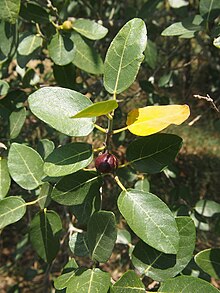Ficus opposita is one of several fig species commonly known as sandpaper figs. It is native to the Northern Territory and Queensland in Australia.Other common names include sweet sandpaper fig,[1] sweet fig[1] and the ambiguous "figwood" and "watery fig".[2]
| Sweet sandpaper fig | |
|---|---|

| |
| Scientific classification | |
| Kingdom: | Plantae |
| Clade: | Tracheophytes |
| Clade: | Angiosperms |
| Clade: | Eudicots |
| Clade: | Rosids |
| Order: | Rosales |
| Family: | Moraceae |
| Genus: | Ficus |
| Subgenus: | F. subg. Sycidium |
| Species: | F. opposita
|
| Binomial name | |
| Ficus opposita | |
| Synonyms | |
| |
It grows as either a shrub or small tree.[1] As the figs ripen, their colour changes from green to yellow to reddish-brown and finally, to black.[1] The fruit is edible and palatable, tastier than most other fig species.[3]
It serves as a food plant for the caterpillars of the Queensland butterfly the common- or purple moonbeam (Philiris innotatus).[4]
The leaves on this plant can treat skin infections such as tinea.[citation needed]
Shown to hybridise with Ficus coronulata.[5]
References
edit- ^ a b c d Low, T. (1991). Wild Food Plants Of Australia. Australia: Angus & Robertson. ISBN 0-207-16930-6.
- ^ "Ficus opposita". Australian Plant Name Index (APNI), IBIS database. Centre for Plant Biodiversity Research, Australian Government.
- ^ Lindsay, Lenore (March 1992). "Fancy a feast? Try a fig". Australian Plants. 16 (130): 251–52.
- ^ Braby, Michael F. (2005). The Complete Field Guide to Butterflies of Australia. Collingwood, Victoria: CSIRO Publishing. p. 228. ISBN 0-643-09027-4.
- ^ Wilde, Brendan C.; Rutherford, Susan; Merwe, Marlien van der; Murray, Megan L.; Rossetto, Maurizio (15 July 2020). "First example of hybridisation between two Australian figs (Moraceae)". Australian Systematic Botany. 33 (5): 436–445. doi:10.1071/SB19048. ISSN 1446-5701.